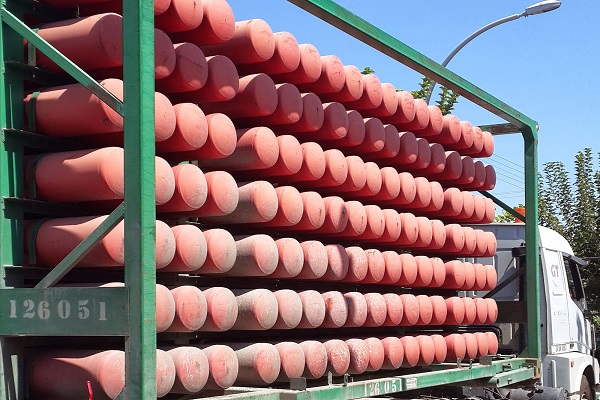Global Compressed Natural Gas (CNG) Tank Market has valued at USD 960.10 million in 2022 and is anticipated to project robust growth in the forecast period with a CAGR of 7.19% through 2028. The Compressed Natural Gas (CNG) Tank market refers to the sector of the global energy industry that involves the manufacturing, distribution, and utilization of specialized containers designed to store and transport compressed natural gas. Compressed natural gas, or CNG, is a cleaner and more environmentally friendly alternative to traditional fossil fuels such as gasoline and diesel. It is primarily composed of methane and is stored under high pressure within CNG tanks to maximize its energy density.
The CNG tank market plays a pivotal role in the broader shift towards sustainable and eco-friendly energy solutions. These tanks are integral components of CNG-powered vehicles, including cars, trucks, buses, and even industrial equipment. They store the compressed gas safely and efficiently, allowing vehicles to operate with reduced greenhouse gas emissions and improved energy efficiency.
The growth of the CNG tank market is influenced by factors such as government policies promoting cleaner energy sources, the need to meet stringent emissions standards, advancements in tank design and technology, and the expansion of CNG refueling infrastructure. As the world seeks to reduce its carbon footprint and transition towards greener transportation options, the CNG tank market is poised for continued expansion and innovation.
Key Market Drivers
Growing Demand for Clean and Sustainable Energy Sources
The global Compressed Natural Gas (CNG) tank market is being driven by the increasing demand for clean and sustainable energy sources. As concerns about environmental pollution and climate change continue to rise, there is a growing emphasis on reducing greenhouse gas emissions. CNG is considered a cleaner alternative to traditional fossil fuels like gasoline and diesel, as it produces fewer emissions when burned. This has led to a surge in demand for CNG-powered vehicles and, consequently, CNG storage solutions, such as CNG tanks.
Download FREE Sample Report @ https://www.techsciresearch.com/sample-report.aspx?cid=16572
Governments and regulatory bodies in many countries are also promoting the use of CNG as a way to meet their carbon reduction targets. Incentives, subsidies, and favorable policies are being implemented to encourage the adoption of CNG-powered vehicles, further boosting the CNG tank market.
Cost-Efficiency of CNG as a Transportation Fuel
Another key driver of the global CNG tank market is the cost-efficiency of CNG as a transportation fuel. CNG is often more affordable than gasoline or diesel, making it an attractive option for commercial fleet operators and individual vehicle owners looking to reduce their fuel expenses. With fluctuating oil prices, CNG provides a stable and cost-effective alternative, contributing to the growth of the CNG tank industry. Additionally, the infrastructure for CNG refueling stations is expanding, making it more convenient for consumers to access CNG as a fuel source. This increased accessibility further drives the adoption of CNG-powered vehicles and the demand for CNG tanks.
Environmental Regulations and Emission Standards
Stringent environmental regulations and emission standards imposed by governments worldwide are significant drivers of the CNG tank market. To comply with these standards and reduce their carbon footprint, industries and transportation sectors are increasingly turning to CNG as a cleaner fuel option. CNG tanks play a crucial role in this transition by storing and delivering natural gas to vehicles and industrial processes with lower emissions. Companies that invest in CNG technology can not only meet current regulatory requirements but also position themselves favorably for future regulations that may become even more stringent. This regulatory-driven demand for CNG tanks is expected to continue to grow.
Technological Advancements in CNG Tank Design
Advancements in CNG tank design and technology are propelling the growth of the global CNG tank market. Manufacturers are continually innovating to create tanks that are lighter, more durable, and safer. Lightweight CNG tanks, for instance, improve vehicle efficiency and reduce the overall weight, resulting in better fuel economy. Enhanced safety features in CNG tanks, such as advanced materials and pressure relief systems, increase their appeal to consumers and industries. These technological advancements not only boost the adoption of CNG-powered vehicles but also drive the replacement market as older, less efficient tanks are upgraded with newer, more advanced ones.
Increasing Adoption of CNG in Public Transportation
The increasing adoption of CNG in public transportation systems is a significant driver for the CNG tank market. Many cities and municipalities are transitioning their public bus fleets to CNG to reduce emissions and promote cleaner air quality. CNG tanks are an essential component of these vehicles, providing the fuel storage needed for daily operations. The shift towards CNG in public transportation is driven by a combination of environmental concerns, cost savings, and government incentives. As more cities embrace CNG for their buses and even taxis, the demand for CNG tanks is set to rise steadily.
Global Expansion of Natural Gas Infrastructure
The global expansion of natural gas infrastructure is another driver of the CNG tank market. As natural gas production and distribution networks grow, CNG becomes a more accessible and viable fuel option for a broader range of applications. This expansion includes the development of pipelines, liquefied natural gas (LNG) terminals, and CNG refueling stations. With an increasing number of refueling stations available, consumers and businesses are more likely to consider CNG as a viable alternative. This infrastructure expansion not only supports the adoption of CNG-powered vehicles but also drives the demand for CNG tanks to store and transport natural gas effectively.
In conclusion, the global CNG tank market is experiencing robust growth driven by a combination of environmental concerns, cost-efficiency, regulatory support, technological advancements, increased adoption in public transportation, and the expansion of natural gas infrastructure. As the world continues to prioritize sustainability and emissions reduction, the CNG tank market is poised for continued expansion in the coming years.
Government Policies are Likely to Propel the Market
Subsidies and Incentives for CNG Adoption
Governments worldwide have implemented subsidies and incentives to promote the adoption of Compressed Natural Gas (CNG) as an alternative fuel source. These policies are designed to encourage vehicle owners and industries to transition from conventional gasoline and diesel to cleaner CNG, thereby reducing greenhouse gas emissions and air pollution. Subsidies typically involve financial assistance to offset the higher initial costs associated with purchasing CNG-powered vehicles and CNG tanks. In some regions, governments offer tax credits or rebates to individuals and businesses who invest in CNG technology. These incentives can significantly reduce the overall cost of CNG adoption, making it a more attractive option. Moreover, some governments provide grants for the installation of CNG refueling infrastructure, including CNG filling stations and storage facilities. This infrastructure support helps build a robust CNG ecosystem, further encouraging its use.
Emission Standards and Regulations
To combat air pollution and reduce greenhouse gas emissions, governments have imposed stringent emission standards and regulations that affect the global CNG tank market. These policies require vehicle manufacturers to produce vehicles that meet or exceed certain emissions thresholds, which often necessitate the use of cleaner fuels like CNG. For instance, the European Union’s Euro 6 emission standard sets strict limits on nitrogen oxide (NOx) and particulate matter emissions from vehicles. To comply with these regulations, automakers increasingly offer CNG options for their vehicles. Consequently, the demand for CNG tanks has surged, as they are essential for storing and delivering natural gas to CNG-powered vehicles. Governments also introduce emissions testing and certification programs, ensuring that CNG-powered vehicles meet prescribed environmental standards. This regulatory framework not only supports the CNG tank market but also encourages innovation in tank design and technology to meet evolving standards.
Infrastructure Development
Governments play a pivotal role in CNG infrastructure development by investing in refueling stations and related facilities. This policy is instrumental in expanding the accessibility of CNG as a transportation fuel. Governments often collaborate with private enterprises to establish a network of CNG filling stations along major highways and in urban centers. In some cases, governments provide grants, low-interest loans, or tax incentives to encourage businesses to invest in CNG refueling infrastructure. This approach helps address one of the main barriers to CNG adoption: the lack of convenient refueling options. Furthermore, governments may enact regulations that require a minimum number of CNG stations to be available within a certain radius or along key transportation routes. This strategic approach ensures that CNG remains a practical and viable option for consumers and fleet operators.
Research and Development Funding
Many governments allocate funds for research and development (R&D) initiatives aimed at advancing CNG tank technology. These investments support the creation of safer, lighter, and more efficient CNG tanks, which, in turn, promote the adoption of CNG as a fuel source. R&D funding can be directed towards materials research, exploring innovative tank designs, enhancing safety features, and improving manufacturing processes. These advancements not only benefit the CNG tank market but also contribute to broader goals of energy efficiency and emissions reduction. Governments may collaborate with academic institutions, research organizations, and private companies to drive innovation in CNG tank technology. This collaborative approach fosters a culture of continuous improvement and ensures that CNG remains a competitive and sustainable energy solution.
Environmental Taxation and Pricing Mechanisms
Environmental taxation and pricing mechanisms are another policy tool employed to support the global CNG tank market. These policies typically involve imposing higher taxes or fees on conventional fossil fuels like gasoline and diesel while providing tax breaks or reduced rates for cleaner alternatives like CNG. By making CNG more economically attractive compared to traditional fuels, governments encourage consumers and businesses to opt for CNG-powered vehicles. This approach not only reduces greenhouse gas emissions but also incentivizes investment in CNG tanks and infrastructure. Furthermore, some regions implement congestion pricing or toll discounts for CNG vehicles, further reducing the overall cost of CNG adoption. These pricing mechanisms are designed to promote the use of cleaner fuels in congested urban areas, improving air quality and reducing traffic-related emissions.
Sustainability and Climate Action Plans
Governments are increasingly incorporating CNG adoption into their sustainability and climate action plans. These comprehensive strategies outline a country’s or region’s commitment to reducing carbon emissions and mitigating the impacts of climate change. As part of these plans, governments set specific targets for the adoption of clean energy sources like CNG. They may mandate that a certain percentage of government-owned vehicles or public transportation fleets must run on CNG. This policy not only showcases government leadership in sustainability but also serves as a catalyst for CNG tank market growth. Additionally, governments may establish long-term roadmaps for transitioning to a greener transportation sector, with CNG playing a vital role. These plans often include funding allocations for CNG infrastructure development, R&D initiatives, and public awareness campaigns to educate consumers about the benefits of CNG adoption.
In conclusion, government policies around the world are instrumental in driving the growth of the global Compressed Natural Gas (CNG) tank market. Through subsidies, emissions standards, infrastructure development, R&D funding, pricing mechanisms, and sustainability plans, governments play a pivotal role in promoting CNG as a cleaner and more sustainable alternative to conventional fossil fuels. These policies not only benefit the environment but also stimulate economic growth in the CNG tank industry and related sectors.
Key Market Challenges
Infrastructure Development and Accessibility
One of the primary challenges facing the global Compressed Natural Gas (CNG) tank market is the development of adequate infrastructure and accessibility. While CNG is considered a cleaner and more environmentally friendly alternative to traditional fossil fuels, its adoption is heavily dependent on the availability of refueling stations and distribution networks. One major hurdle is the upfront investment required to establish a network of CNG refueling stations. These stations need to be strategically located along highways, in urban areas, and near industrial centers to make CNG a practical choice for consumers and businesses. Governments and private investors must collaborate to fund and build this infrastructure, which can be a time-consuming and capital-intensive process. Accessibility is another issue, particularly in rural or Compressed Natural Gas (CNG) Tank areas where CNG refueling stations are scarce or nonexistent. As a result, individuals and businesses in such areas may be reluctant to invest in CNG-powered vehicles or equipment due to concerns about fuel availability during their journeys. Furthermore, the adoption of CNG in long-haul transportation, such as freight trucks, faces challenges related to the establishment of a comprehensive network of CNG refueling stations along major transport routes. This is essential to ensure that CNG-powered commercial vehicles can operate efficiently and without interruptions. Addressing this infrastructure challenge requires concerted efforts from governments, the private sector, and regulatory bodies. Collaboration is necessary to develop a well-connected and accessible CNG refueling network that spans urban, suburban, and rural areas. Overcoming this challenge is vital for the continued growth of the global CNG tank market.
Competition from Alternative Fuel Technologies
Another significant challenge confronting the global Compressed Natural Gas (CNG) tank market is the increasing competition from alternative fuel technologies. While CNG is known for its relatively lower carbon emissions and cost advantages compared to traditional gasoline and diesel, it faces competition from other alternative fuels, such as electricity and hydrogen. nElectric vehicles (EVs) have gained considerable traction in recent years, thanks to advancements in battery technology, an expanding charging infrastructure, and strong consumer interest.
EVs offer zero tailpipe emissions and are perceived as a cleaner alternative to both CNG and traditional fossil fuels. Hydrogen fuel cell technology is another contender. Hydrogen-powered vehicles offer zero emissions and can be refueled quickly, making them attractive for certain applications, such as heavy-duty trucks and public transportation. Governments and industries are investing in hydrogen infrastructure and research, potentially diverting attention and resources away from CNG. The rise of these alternative technologies creates a competitive landscape for CNG, particularly in the passenger car and public transportation sectors. The challenge lies in demonstrating the distinct advantages of CNG, such as its lower greenhouse gas emissions and cost-effectiveness, compared to these alternatives.
To address this challenge, stakeholders in the CNG tank market need to emphasize the benefits of CNG, including its well-established infrastructure in some regions, energy efficiency, and compatibility with existing internal combustion engine technology. Continued innovation in CNG tank design, safety, and efficiency will also be crucial to maintaining its competitiveness in a rapidly evolving market for alternative fuels. Additionally, collaboration with governments and industries to develop integrated energy strategies that include CNG as a key component can help position it as a viable and sustainable choice for the future.
Related Reports
Industrial UPVC Doors & Windows Market [2028] – Analysis, Trends, & Insights
GRP Pipes Market [2028]: Trends & Forecast
Plastic Caps and Closures Market – Future, Scope, Trends [2028]
Table of Content-Compressed Natural Gas (CNG) Tank Market
- Product Overview
1.1. Market Definition
1.2. Scope of the Market
1.2.1. Markets Covered
1.2.2. Years Considered for Study
- Key Market Segmentations
- Research Methodology
3.1. Objective of the Study
3.2. Baseline Methodology
3.3. Formulation of the Scope
3.4. Assumptions and Limitations
3.5. Sources of Research
3.5.1. Secondary Research
3.5.2. Primary Research
3.6. Approach for the Market Study
3.6.1.The Bottom-Up Approach
3.6.2.The Top-Down Approach
3.7. Methodology Followed for Calculation of Market Size & Market Shares
3.8. Forecasting Methodology
3.8.1.Data Triangulation & Validation
- Executive Summary
- Voice of Customer
- Global Compressed Natural Gas (CNG) Tank Market Outlook
6.1. Market Size & Forecast
6.1.1. By Value
6.2. Market Share & Forecast
6.2.1. By Raw Material (Glass Fiber Composites, Carbon Fiber Composites, Others),
6.2.2. By Propulsion (Petrol, Diesel),
6.2.3. By Vehicle Type (Passenger, Light Commercial, Heavy Commercial Vehicles),
6.2.4. By Type (Type 1 CNG Tanks, Type 2 CNG Tanks, Type 3 CNG Tanks, Type 4 CNG Tanks)
6.2.5. By Region
6.2.6. By Company (2022)
6.3. Market Map
- North America Compressed Natural Gas (CNG) Tank Market Outlook
7.1. Market Size & Forecast
7.1.1. By Value
7.2. Market Share & Forecast
7.2.1. By Raw Material
7.2.2. By Propulsion
7.2.3. By Vehicle Type
7.2.4. By Type
7.2.5. By Country
7.3. North America: Country Analysis
7.3.1. United States Compressed Natural Gas (CNG) Tank Market Outlook
7.3.1.1. Market Size & Forecast
7.3.1.1.1. By Value
7.3.1.2. Market Share & Forecast
7.3.1.2.1. By Raw Material
7.3.1.2.2. By Propulsion
7.3.1.2.3. By Vehicle Type
7.3.1.2.4. By Type
7.3.2. Canada Compressed Natural Gas (CNG) Tank Market Outlook
7.3.2.1. Market Size & Forecast
7.3.2.1.1. By Value
7.3.2.2. Market Share & Forecast
7.3.2.2.1. By Raw Material
7.3.2.2.2. By Propulsion
7.3.2.2.3. By Vehicle Type
7.3.2.2.4. By Type
7.3.3. Mexico Compressed Natural Gas (CNG) Tank Market Outlook
7.3.3.1. Market Size & Forecast
7.3.3.1.1. By Value
7.3.3.2. Market Share & Forecast
7.3.3.2.1. By Raw Material
7.3.3.2.2. By Propulsion
7.3.3.2.3. By Vehicle Type
7.3.3.2.4. By Type



